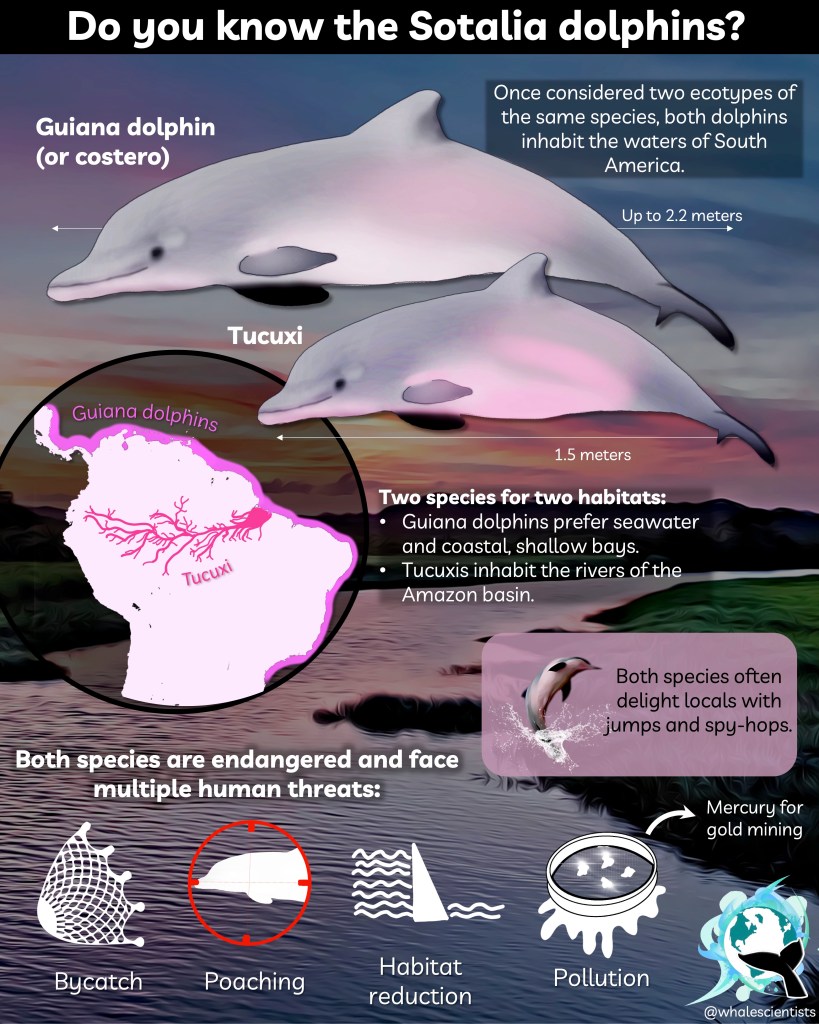Welcome back to our Whale of the Month series! After taking a short break, we decided to introduce Sotalia dolphins this month. These mysterious dolphins live in both the sea and the rivers of South America. They include two species: the Guiana dolphin or costero, and the tucuxi. These tiny little dolphins face many human threats across their habitat. Let’s find out more about them today!

One or two species?
The name “Sotalia” is the genus common to both species. Sotalia guianensis, also called the Guiana dolphin (or costero), is a close cousin to Sotalia fluviatilis, the tucuxi. Both species are very similar morphologically, so much so that scientists once believed they were two ecotypes of the same species (just like transient and resident killer whales, for example). DNA analyses published in 2005 and 2007 confirmed that these two ecotypes were significantly different, and each deserved its own name. As a result, the tucuxi lives mainly in the rivers of South America, while the Guiana dolphin resides in shallow coastal waters. Both species are part of the Delphininae subfamily and are closely related to bottlenose dolphins or humpback dolphins.
A social dolphin
Both species live in small, tight-knit groups but can occasionally socialize with larger groups or even other dolphin species. They can be quite active at the surface and often breach, spy-hop, and tail-splash, just like their bottlenose dolphin cousins. Scientists believe both species live up to 30-35 years.
Although Sotalias are quite social and seem to form tight-knit relationships, they can also show violent behaviors. A team of scientists witnessed potential infanticide in a group of Guiana dolphins in 2006. The event involved a newborn calf, its mother, and six adult dolphins. The adults separated the calf from its mother and attacked it for 17 minutes by holding it underwater and throwing it in the air. The mom tried to rescue her calf, but her efforts were stopped by some of the adults who kept her away from her offspring. After the event, the calf was never seen again and was presumed dead. This is not the first report of infanticide in dolphin species, and we have an entire post dedicated to this type of event here, if you wish to know why dolphins do it.
Threats to Sotalias’ survival
Both species face significant human threats to their survival. Tucuxis are endangered under the IUCN red list, and Guiana dolphins are near threatened. Population estimates are difficult to gather, but one study estimated that the population of Guiana dolphins residing in the waters of Southern Brazil decreased by 90% in three decades! Here are some of the threats they face.

Bycatch
These small dolphins live close to the shore, where fishermen use gillnets and seine nets. Getting caught in these nets causes a lot of stress on the small dolphins, and their efforts to escape them usually result in further entanglement and suffocation.
Poaching
In some areas, Guiana dolphins can get killed and used as shark bait or even eaten by certain communities. But the species that face the most significant poaching threat is the tucuxi. In the traditional local cultures, tucuxi’s organs have several aphrodisiac and medicinal properties. Their body parts (eyes, teeth, genitals) can also be used as charms that promote luck, financial success, and love.
Pollution and habitat loss
Gold panning uses a large amount of mercury that gets dumped in the rivers the tucuxi calls home. As a result, dolphins accumulate large amounts of this toxic metal, which in turn can damage their organs and affect both their immune and reproductive systems. Both dolphin species also suffer from exposure to persistent organic contaminants and microplastics.
On top of pollution, these dolphins, and the tucuxi, in particular, face the degradation of their traditional habitat. Indeed, the development of hydroelectric plants causes the multiplication of large dams in the Amazon basin. This increase results in a poorer-quality habitat and groups get isolated from one another, which prevents good gene flows and genetic diversity in the dolphin populations.
Conservation efforts
So what can we do to preserve Sotalia dolphins? Well, first things first, both species are currently protected in most countries across their range. For the tucuxi particularly, there are plans in action to discourage locals from poaching. We, as citizens of the world, can spread the information and try to support local monitoring efforts. These efforts are key to understanding more about Sotalia dolphins and how we can protect them. We invite you to go check out the Omacha fundación, which works on protecting all Amazon river dolphins in Columbia.
Sources and further reading
- Caballero, S., et al. “Taxonomic status of the genus Sotalia: species level ranking for “tucuxi”(Sotalia fluviatilis) and “costero”(Sotalia guianensis) dolphins.” Marine mammal science 23.2 (2007): 358-386.
- Flores, Paulo AC, Vera MF Da Silva, and Daniela de C. Fettuccia. “Tucuxi and Guiana dolphins: Sotalia fluviatilis and S. guianensis.” Encyclopedia of marine mammals. Academic Press, 2018. 1024-1027.
- Hauser-Davis, Rachel Ann, et al. “Subcellular cadmium, lead and mercury compartmentalization in Guiana dolphins (Sotalia guianensis) From Southeastern Brazil.” Frontiers in Marine Science 7 (2020): 584195.
Did you enjoy this post? Find out about other endangered river dolphins here:
The endangered Yangtze finless porpoise
Anaïs is the founder of Whale Scientists. She is a PhD student at McGill University working on killer whale ecology and pollution. You can read more about her here.





